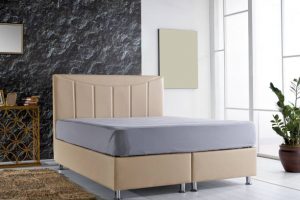The humble bed frame, often overshadowed by its mattress counterpart, plays a pivotal role in our sleep sanctuary. Not only does it provide structural support, but it also sets the tone for bedroom aesthetics and contributes to the overall quality of our sleep. Recent years have seen a seismic shift in bed frame designs, moving away from merely functional to innovative and sustainable options that cater to a wide array of personal preferences and environmental concerns. This exploration delves into the evolution, current trends, and future trajectory of bed frame designs, underscoring the fusion of form, function, and sustainability.
Historical Perspectives: More Than Just a Place to Rest
The history of the bed frame traces back to ancient civilizations, evolving from simple mats on the ground to elaborate constructions. Early designs in Egypt utilized raised platforms to avoid pests, with lavish decorations for the elite. The Romans introduced luxury in the form of silver and gold bedsteads, while the Middle Ages saw the bed become a symbol of status, culminating in the ornate four-poster beds of the Renaissance. This historical progression reflects not only changes in technology and materials but also the bed frame’s status as a marker of social standing and cultural values.
Modern Innovations: Marrying Comfort with Aesthetics
The contemporary era has ushered in a renaissance of bed frame design, emphasizing personal expression, comfort, and minimal environmental impact. Innovations such as adjustable bases, built-in storage, and smart technology integration reflect the modern consumer’s desire for functionality and convenience. Materials have diversified to include sustainable options like bamboo, reclaimed wood, and recycled metals, aligning with the growing demand for eco-friendly products.
Adjustable Frames: Tailoring Sleep to Your Needs
Adjustable bed frames, once exclusive to hospitals, have gained popularity for their health benefits and comfort. Offering the ability to elevate the head or feet, these frames cater to a range of needs, from reducing snoring to alleviating back pain. The integration of technology allows for features like massage, zero gravity settings, and connectivity with smart home devices, providing a customized sleep experience.
Storage Solutions: Maximizing Space with Style
With urban living spaces shrinking, the need for multifunctional furniture has never been greater. Bed frames with built-in storage, such as drawers or hydraulic lift systems, offer a solution to clutter without compromising on style. These designs are particularly beneficial in smaller bedrooms, where maximizing floor space is paramount.
Sustainable Choices: Eco-Friendly Materials and Practices
The shift towards sustainability has profoundly influenced bed frame design. Consumers are increasingly opting for materials that are not only durable and stylish but also kind to the planet. Sustainable wood, certified by organizations like the Forest Stewardship Council (FSC), ensures responsible forest management. Recycled metals and plastics offer an alternative to virgin materials, reducing waste and energy consumption. Moreover, the trend towards locally sourced materials and craftsmanship supports local economies and reduces the carbon footprint associated with transportation.
The Future of Bed Frames: Innovation and Individualization
Looking ahead, the future of bed frame design promises even greater personalization and innovation. The rise of 3D printing technology offers the potential for customized bed frames tailored to individual body types and preferences, revolutionizing the concept of personalized comfort. Augmented reality (AR) and virtual reality (VR) could transform the shopping experience, allowing consumers to visualize how different bed frames fit into their existing bedroom decor before making a purchase.
Sustainability will continue to drive innovation, with designers exploring new materials and manufacturing processes that further reduce environmental impact. The circular economy concept, focused on reducing waste and promoting reuse and recycling, will likely influence bed frame design and production, leading to products designed for longevity and recyclability.
Conclusion: Embracing the Bed Frame Renaissance
The bed frame, far from being a mere support structure for the mattress, has emerged as a central element in the quest for comfortable, aesthetically pleasing, and sustainable living spaces. As we continue to explore and embrace innovations in design and materials, the bed frame stands as a testament to human creativity and our evolving relationship with the environment. Whether through advanced technology, ingenious storage solutions, or sustainable manufacturing practices, the evolution of bed frame design mirrors our collective journey towards a more personalized, comfortable, and environmentally responsible lifestyle. In this ongoing renaissance, the bed frame is more than just furniture; it is a canvas for innovation, a reflection of cultural values, and a cornerstone of sustainable living.















Add Comment